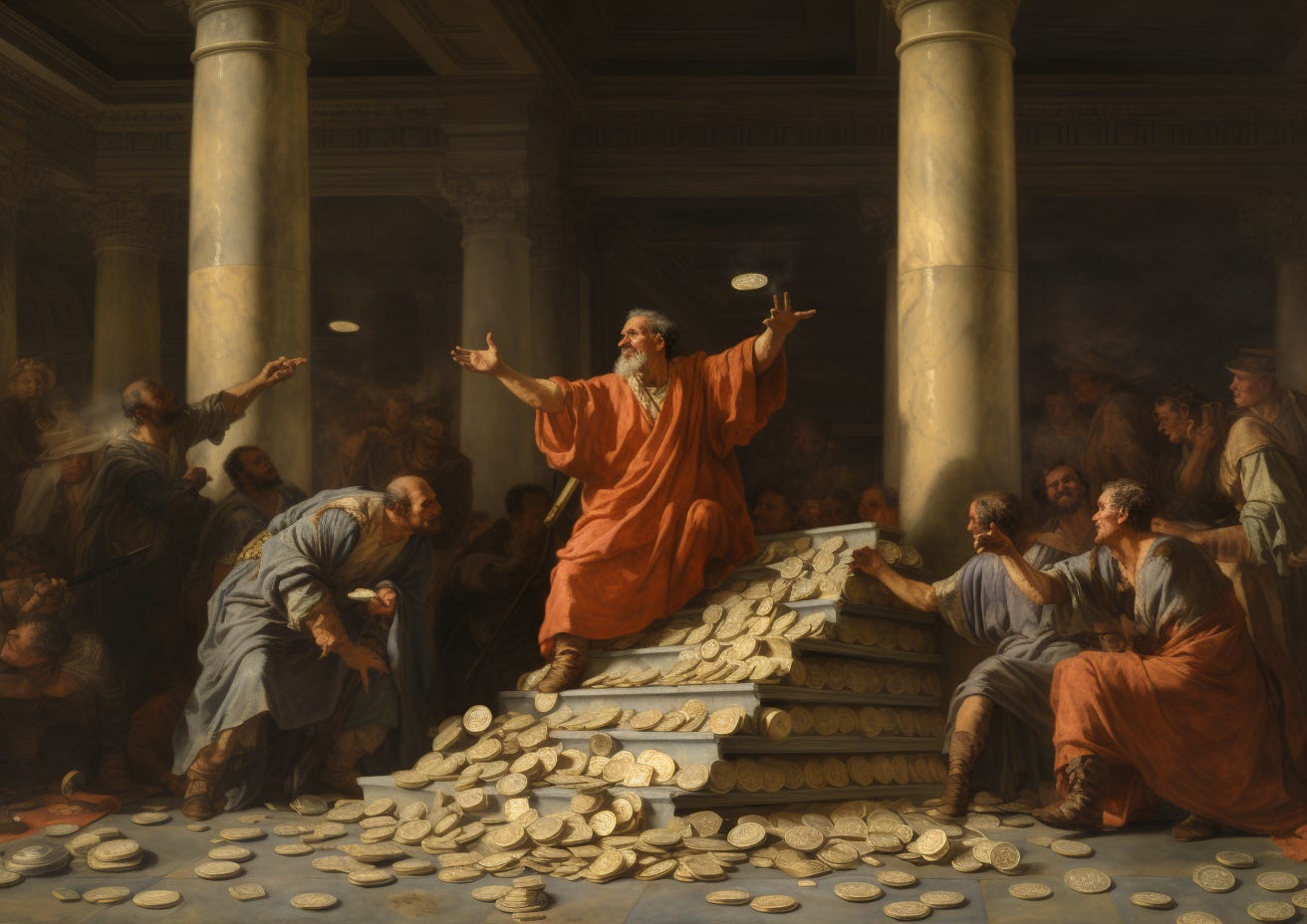
The Flying Frisby - money, markets and more
Business:Investing

The Rise and Fall of Sound Money in Ancient Rome
 2023-08-27
2023-08-27
This is the last of these pieces about gold in ancient history. I’m back from the Edinburgh Fringe now, and more regular market commentary will resume.
Lots of exciting things happening on this Substack. If you missed them this week, check out Wednesday’s piece on uranium, the coming supply squeeze and how to play this (almost) inevitable bull market. On Monday I covered bitcoin - in particular, how UK investors can get exposure via a traditional broker (and thus have it in their SIPP or ISA). And Friday I told the story of one of the maddest gigs I have ever done.
Coming up this week: Dr John will be sharing his picks of the North American oil and gas plays. Plus together, with Dr John and Charlie Morris of Bytetree, I have been working on the the Do F All portfolio: a do-very-little portfolio for the hands-off investor, who wants to invest his or her money safely and well, without constantly having to monitor it. There’ll be a podcast and a piece about that very soon.
So look out for all of those. For now, your Sunday morning thought piece, a historical piece with many parallels to today: the Romans and the debasement of money.
The Roman Empire is probably more famous for debasing its currency, than for its money itself. But for that debasement to have been so prolonged (it went on for hundreds of years) and, some might say, effective, it needed an established, widely recognised and credible money as a starting point. Here look at the rise and full of sound money in Ancient Rome. There are many parallels to today.
The geology of central Italy is not particularly abundant in gold and silver, and it was only really after Rome began expanding beyond central Italy in the third century BC that it started using gold and silver. Commodity money tends to be determined by the resources available. Bronze (copper and tin) is abundant in the area, and bronze, in the form of weights - aes rude, often as heavy as 11oz (300g) - was the early currency of choice.
As the Republic expanded, so did access to gold and silver, either from loot, tribute or mine supply, and so did these precious metals make their way into Roman money. The first silver denarius was minted in 211BC. Within 50 or 60 years Roman coinage was widespread across Italy. Much of the silver to mint the coins came from mines in Macedonia, which Rome now controlled.
For the next 500 years this silver coin, containing about just over 1/8th of an ounce (4g) of silver - a little bit more than the weight of a 1p coin - would be the backbone currency of Rome. One denarius was exchangeable for ten asses (the aes rude evolved to become the as) - hence its name “of ten”, or tenner. It was 95-98% pure silver. To give you some kind of benchmark, sterling silver is only 92.5% pure.
The purchasing power of a denarius would be more than the underlying metal value - ranging between 1.5 and 3 times the value. That’s seigniorage for you.
The denarius lives on today, especially in many Latin languages. The Italian word for money is “denaro”, “dinero” is Spanish, “dinheiro” is Portugese, “denar” is Slovenian. In many Arab nations, the currency is the dinar. The symbol for the English penny used to be ‘d’ - as in 1d.
Heads of emperors appeared on coins, and so, as a result, did their use as imperial propaganda. The more coins circulating around the ever-growing empire, spreading the message of Roman imperial might, the better.
As a side note, consider this Trajan denarius from AD 101. On the reverse we see Providentia, Roman goddess of foresight, overlooking a globe (the world, the empire).
Similarly, this Roman aureus of Hadrian from 117AD, when he became emperor, and when the Roman empire was at its most extensive, shows, on the reverse, Trajan, the previous emperor (on the right) passing a globe - the empire - to Hadrian who accepts it.
This Hadrian sestertius (there were four of these brass coins to a denarius) tells the same story.
This surely kills the notion that people thought the earth was flat. Several centuries earlier Aristotle had argued that the world was round saying. "the Earth is spherical". While in 240 BC, Greek astronomer Eratosthenes actually calculated the circumference of the earth, and accurately, by measuring the angles of shadows.
Coin clipping and the debasement of money
The infamous debasement only began shortly after the Republic became Empire, and control of money passed from the Senate to the Emperor. It lasted several hundred years.
By the first century AD, taxation and tribute only covered around 80% of the imperial budget. The shortfall was met by mining and the loot of newly conquered nations. But the empire was no longer expanding at the same rate, so this was becoming an increasingly risky strategy. Shortfalls, especially under extravagant emperors, became increasingly common. The solution to excess spending, as today, was not to rein it in, but to debase the currency. In AD64 Nero reduced both the amount of silver in a denarius (to 3.5grams) as well as the purity of the metal itself (to 93.5%).
A few decades later, under Trajan, the Roman Empire reached its greatest extent. From then on, it receded. That meant the supply of loot from newly conquered territories also receded.
By lowering the amount of silver in its coins, Rome could produce more coins and "stretch" its budget. Successive emperors followed Nero’s strategy. As with boiling frogs and the debasement of currency today, the process was gradual. 100 years after Nero, around 150AD, the purity of silver had been reduced to 83%. By 250AD the silver purity was 50%.
But then the debasement accelerated. By 275AD it was just 5%. As time progressed, the sleight of hand was exposed. By the time of Diocletian, who was emperor from 284 to 305AD, there was so little precious metal in the money, the emperor had to resort to price controls. It was under Diocletian that the last denarii were minted.
The most important gold coin of Ancient Rome was the aureus, similar in size to the denarius, but containing roughly twice the weight of precious metal (gold is denser than silver). It would be a bit heavier than a 2p today. An aureus was 25 denarii, so the gold-silver ratio would have been about 1:12, the historical norm.
Nero reduced the gold content to 7.3g (coincidentally perhaps the same weight as the sovereign of the British Empire). By 210AD the gold content had fallen to 6.3g. However, unlike the silver denarius, the aureus kept its near-100%, 24-karat purity.
By the fourth century, the idea of obtaining an aureus for 25 denarii was long gone. In 301, one gold aureus was worth 833 denarii; barely a decade later, the same aureus was worth 4,350 denarii.
In 337, Constantine, who had re-located the heart of the Empire to Constantinople, replaced the aureus with the solidus - about 4.5 grams of 24 karat gold. Initially, one solidus was worth 275,000 denarii, but by 356, one solidus was worth 4,600,000 denarii. Talk about inflation.
(That last stat is from Wikipedia and it sounds dubious).
However, in a breathtaking show of hypocrisy that even leaders today would struggle to pull off, the Roman authorities, despite the declining quality of the metal content of their denarius, refused to accept anything other than gold and silver in payment of taxes. Take in the good money, send out the bad.
Of course, one key reason for the relentless debasement was a bloated Roman state that was incapable of living within its means. But another reason must be lack of raw material. As central Italy had little supply, the metal had to be obtained elsewhere and most of it came in the form of war booty and the subsequent tributes and taxes levied. No wonder Rome was constantly at war. That was its business model. But the expense of continual wars, without the corresponding payback of loot from the newly conquered, made the model unsustainable. The expansion ceased, but the spending didn’t.
Interested in buying gold to protect yourself in these uncertain times? My recommended bullion dealer is The Pure Gold Company, whether you are taking delivery or storing online. Premiums are low, quality of service is high. They deliver to the UK, US, Canada and Europe, or you can store your gold with them. More here.
This is a public episode. If you’d like to discuss this with other subscribers or get access to bonus episodes, visit www.theflyingfrisby.com/subscribe
More Episodes
 2024-10-16
2024-10-16
 2024-09-22
2024-09-22
 2024-09-15
2024-09-15
 2024-09-11
2024-09-11
 2024-08-28
2024-08-28
 2024-08-25
2024-08-25
 2024-08-22
2024-08-22
Create your
podcast in
minutes
- Full-featured podcast site
- Unlimited storage and bandwidth
- Comprehensive podcast stats
- Distribute to Apple Podcasts, Spotify, and more
- Make money with your podcast
It is Free
- Privacy Policy
- Cookie Policy
- Terms of Use
- Consent Preferences
- Copyright © 2015-2024 Podbean.com




